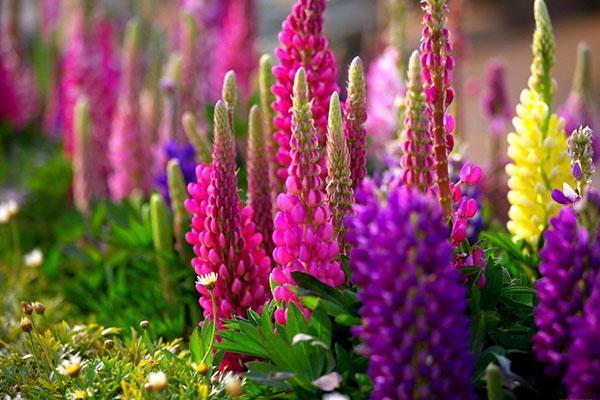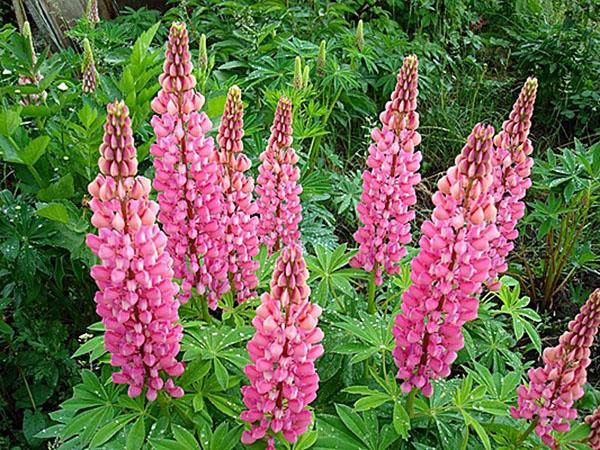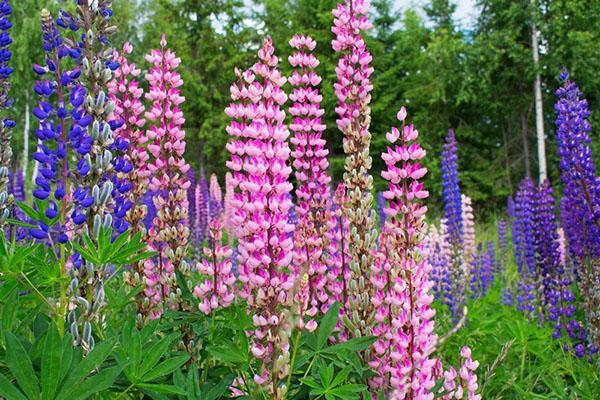Popular types and varieties of lupine: description, plant care
 There are different types and varieties of lupine in the world. They differ in the shade of the inflorescences, the size of the bushes, and also in the way of care. In order for a beautiful and bright lupine to please its owners, it is necessary to provide the flower with appropriate watering and feeding. It is also important to properly prepare the plant for wintering.
There are different types and varieties of lupine in the world. They differ in the shade of the inflorescences, the size of the bushes, and also in the way of care. In order for a beautiful and bright lupine to please its owners, it is necessary to provide the flower with appropriate watering and feeding. It is also important to properly prepare the plant for wintering.
Description of the appearance of the plant

The root of the leguminous plant is tapicular, very long, and grows up to 2 m in depth. Its flowers can be of various shades. All of them form among themselves inflorescences-brushes, which look like a candle. The buds are located alternately or whorled. More than 200 varieties of lupine grow on different continents.
If the lupine is infected with powdery mildew or false rust, it is necessary to immediately cut and destroy all damaged parts of the flower, this will help it to form young, uninfected shoots.
In addition to decorative purposes, the stem of the plant and its seeds are used in the food industry. Straw is used in papermaking. The stems of the plant are also often used for decorative crafts.
Due to their rich composition, lupine seeds are used in medicine. They are added in the manufacture of plasters and various drugs. In cosmetology, grains are included in soaps and other cosmetics.
The most popular types and varieties of lupine
 In agriculture, annual forage plant varieties of white and yellow color, as well as a multi-leaved species are grown. These plants are the easiest to care for and at the same time have many useful components in their composition.
In agriculture, annual forage plant varieties of white and yellow color, as well as a multi-leaved species are grown. These plants are the easiest to care for and at the same time have many useful components in their composition.
It is believed that lupine is an ancient inhabitant of the planet, which appeared in the Cretaceous period.
The main types and varieties of lupine:
- Lupine is dwarf. This variety forms small shrubs. Their height reaches 20-50 cm. The foliage has a gray-green tint. The inflorescences are lush, deep blue with yellowish blotches. Dwarf lupine blooms throughout the summer. At the end of flowering, fruits appear in the form of beans. You need to collect them in the canopy, when the shell becomes brown. Sow grains on flower bedsstarting in April. This variety has a high germination rate. And the adult plant itself does not require specific cultivation conditions.

- Lupine is yellow. This variety belongs to the group of annuals. The pubescent stem reaches a meter in height. The plant differs in a small number of leaves. The plates have long petioles and consist of several segments (5-9). Yellow buds. During flowering, a fragrance spreads resembling mignonette... The seeds are slightly flattened on the sides.

- Lupine is narrow-leaved or blue. This variety also has a pubescent stem reaching 80 cm, sometimes 1.5 meters in height. The leaves are palmate. Their lower part is abundantly covered with fine hairs. Inflorescences come in a variety of colors, from light white to purple. This type of lupine does not exude aroma when it blooms.

An equally common variety is the multi-leaved lupine. It grows up to 1.5 m tall. The stem is smooth. As for the leaves, they are slightly pubescent below. The height of lupine inflorescences reaches 30 cm.They are formed from flowers of a deep blue hue.
This plant blooms for 23 days, but the period can be extended if the wilted buds are removed in a timely manner. This stimulates the plant to bloom in the fall.
Lupine is white and tree-like
 White lupine is a plant that can grow to about 1.5 m in height. Stems are straight, slightly branched at the top. The flowers are often white, but also blue and pink. They are placed on the inflorescence in a spiral. The foliage is glossy above, and covered with small hairs below. Each of the plates has a light border. The flower is beautiful, but without scent.
White lupine is a plant that can grow to about 1.5 m in height. Stems are straight, slightly branched at the top. The flowers are often white, but also blue and pink. They are placed on the inflorescence in a spiral. The foliage is glossy above, and covered with small hairs below. Each of the plates has a light border. The flower is beautiful, but without scent.
The most popular varieties of white lupine are:
- Desnyansky. This is a mid-season variety that grows this variety up to 1.2 meters in height. The plant is distinguished by its good resistance to fusarium. The inflorescences are snow-white in color.

- Degas white lupine. The flower does not grow higher than 90 cm. This variety is not prone to shedding of beans, it is resistant to diseases. The seeds are whitish. Fruits are attached to the main stem and lateral shoots. Lupine of the Degas variety belongs to early maturing plants. With proper care, it gives a good harvest.

- Gamma. This is the earliest variety. The flowers of the plant are light blue. At the end of flowering, white seeds form in their place. In height, an adult plant reaches 0.6-0.8 m. When growing such a lupine in your garden, you should remember that it does not like excess moisture.

Arboreal lupine is a perennial that forms a large shrub about 1 m wide. The plant grows up to 2 m upwards. The stem is highly branched. The foliage is gray-green with oval "fingers". Inflorescences are lush white, honey or purple.
Other plant species
In the garden, several more species of annual and perennial lupine are grown.
Lupine undersized aka silver
 This type of lupine belongs to perennials. It grows in the form of a semi-shrub, consisting of several shoots from 20 to 60 cm in height. Finger foliage underneath is covered with small villi. Each plate consists of 6-9 segments, sometimes even 15. Inflorescences are double-colored, dark below, and white above.
This type of lupine belongs to perennials. It grows in the form of a semi-shrub, consisting of several shoots from 20 to 60 cm in height. Finger foliage underneath is covered with small villi. Each plate consists of 6-9 segments, sometimes even 15. Inflorescences are double-colored, dark below, and white above.
MyCastel (Red Lupine)
 This is the smallest variety. The bush can grow up to 50 cm in height. As the name suggests, this variety blooms with red flowers at the very beginning of summer. If dry buds are removed in a timely manner, this will lead to re-flowering at the end of summer.
This is the smallest variety. The bush can grow up to 50 cm in height. As the name suggests, this variety blooms with red flowers at the very beginning of summer. If dry buds are removed in a timely manner, this will lead to re-flowering at the end of summer.
Lupine decorated
 An annual with a strong, straight stem, about 80 cm high, the foliage is tender, with a silvery pile on the lower part. Each leaf consists of 7-9 "fingers" with elongated petioles. Blooming lupine looks very beautiful with its semi-whorled or whorled inflorescences. The corollas of the opened buds are purple, blue or white. The inner part of the sail is yellow, slightly fleecy.
An annual with a strong, straight stem, about 80 cm high, the foliage is tender, with a silvery pile on the lower part. Each leaf consists of 7-9 "fingers" with elongated petioles. Blooming lupine looks very beautiful with its semi-whorled or whorled inflorescences. The corollas of the opened buds are purple, blue or white. The inner part of the sail is yellow, slightly fleecy.
Lupine is fickle
 This variety belongs to heat-loving plants. In severe frost, the plant often dies, so in our region it is grown as an annual. A flower grows in the form of a bush, the height of which reaches 0.7-1 meters.
This variety belongs to heat-loving plants. In severe frost, the plant often dies, so in our region it is grown as an annual. A flower grows in the form of a bush, the height of which reaches 0.7-1 meters.
It is sown in open ground in late spring. If done correctly, then in June the lupine will begin to bloom its light yellow flowers.
The peculiarity of this variety is that the upper petal is blue in color, which then smoothly turns into scarlet. You can observe the flowering process for about 2 months.
Arctic lupine
 This variety is also undersized. The bush grows up to 40 cm in height. The Arctic lupine is native to the lands of Alaska. The leaves are palmate. Inflorescences can be of different shades of blue: from rich to pale blue. The flower petals are slightly pubescent.
This variety is also undersized. The bush grows up to 40 cm in height. The Arctic lupine is native to the lands of Alaska. The leaves are palmate. Inflorescences can be of different shades of blue: from rich to pale blue. The flower petals are slightly pubescent.
With a reasonable selection of varieties, a very beautiful composition will turn out. If there are other flowers in the flowerbed, then it is better to place the lupine in the background. Plants of short stature are suitable for curb formation.